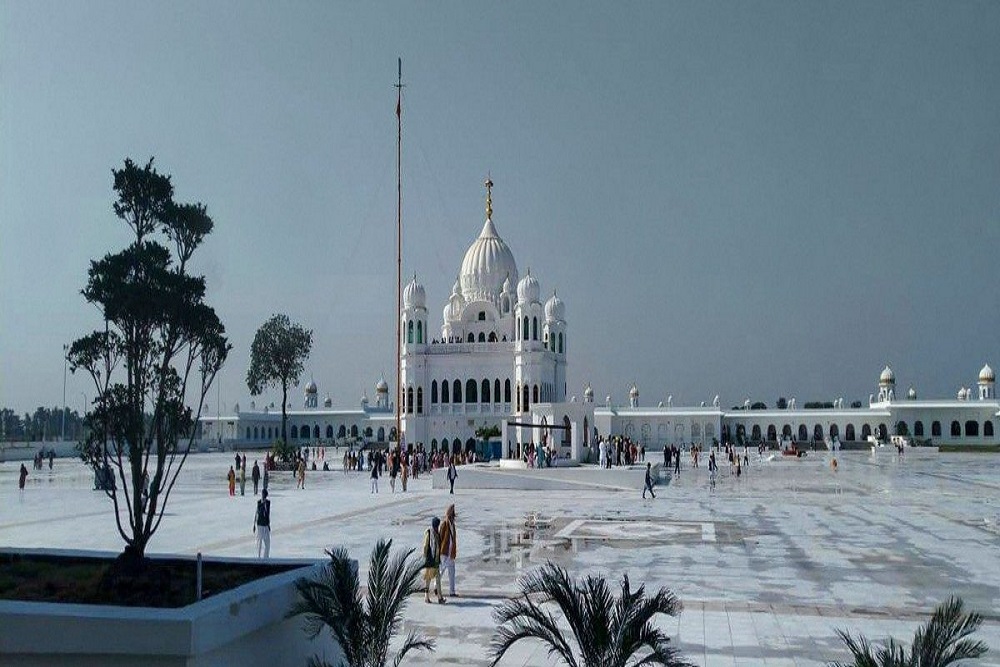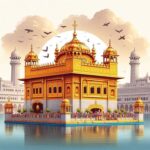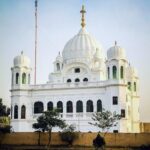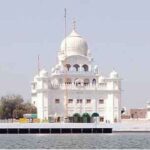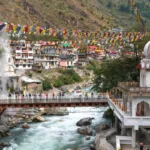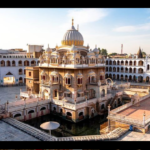Kartarpur (Punjabi (Shahmukhi), Urdu: Punjabi (Gurmukhi): ) is a town in Punjab, Pakistan, located in the Shakargarh Tehsil, Narowal District. It is supposed to have been built by the first guru of Sikhism, Guru Nanak, on the right bank of the Ravi River, where he established the first Sikh commune.
Geography
Kartarpur is located at 32°5′13′′N 75°1′0′′E. It is in the Narowal District of Punjab, Pakistan. It has an elevation of 155 meters on average (511 feet).
History
Guru Nanak, the first guru of Sikhism, founded Kartarpur in 1504 AD on the right bank of the Ravi River. Kartarpur derives its name from Punjabi ” (Kartar) meaning “Creator” or “Lord of Creation” and ” (Pur) meaning “City”. Everyone, regardless of faith or caste, lived together in the first ‘Sikh commune’. Guru Nanak and his family settled in Kartarpur after traveling for about 20 years. Following his death in 1539, Hindus and Muslims both claimed him as their own and built mausoleums in his honor, separated by a common wall. The mausoleums were finally washed away by the Ravi River’s changing flow. However, Guru Nanak’s son saved the urn carrying his father’s ashes and reburied it on the river’s left bank, where a new settlement was built, signifying the present-day Dera Baba Nanak. After Nanak’s death, his successor, Guru Angad, relocated the early Sikh community’s headquarters from Kartarpur to the village of Khadur.
The Gurdwara Kartarpur Sahib was established near the site where Guru Nanak is supposed to have died. It is regarded as the Sikh religion’s second holiest location.
During India’s split in 1947, the region was partitioned between India and Pakistan. The Radcliffe Line granted Pakistan the Shakargarh tehsil on the right bank of the Ravi river, including Kartarpur, and India the Gurdaspur tehsil on the left bank of the Ravi.
Kartarpur Road Corridor
On November 9, 2019, Prime Minister Imran Khan launched the cross-border Kartarpur Corridor, which will allow Indian Sikhs to visit Pakistan without a visa. The first Jatha (batch) of approximately 500 Indian pilgrims visited the shrine on the same day, honoring Prime Minister Khan for “respecting India’s sensitivities” toward the shrine across the border that marks the ultimate resting place of Sikhism’s founder, Guru Nanak Dev.
The first Jatha proceeded through the corridor into Pakistan to pay obeisance to Gurdwara Darbar Sahib Kartarpur, headed by Akal Takht Jathedar Giani Harpreet Singh and featured former Indian Prime Minister Manmohan Singh. The delegation also featured the ex-Prime Minister’s wife, Gursharan Kaur, as well as Punjab Chief Minister Captain Amarinder Singh, Navjot Singh Sidhu, Sunny Deol, and 150 Indian legislators. Demography
The majority of the population is Punjabi. The majority of people are Gurjars, Rajputs, or Jats. Following Punjab’s partition in 1947, the minority Hindus and Sikhs went to India, while many Muslim refugees from India settled at Kartarpur. Significance
The Gurdwara was created to commemorate the location where Guru Nanak, the founder of Sikhism, resided and conducted farming following his missionary activity.
In 1504, Guru Nanak built Kartarpur by ploughing the fields and establishing a common kitchen, or Langar.
He established a Sikh commune there and remained there for 18 years until his death on September 22, 1539. The gurudwara was constructed on the site where Guru Nanak is claimed to have died. It is thus the Sikh religion’s second holiest shrine, after Gurdwara Janam Asthan in Nankana Sahib, Pakistan, which is the birthplace of Guru Nanak.
Shrine
The Shrine is located in Kartarpur, a small village in Punjab besides the River Ravi, and it is one of the holiest destinations for up to 30 million Sikhs worldwide. Sardar Bhupinder Singh, Maharaja of Patiala, donated Rs. 1,35,600 for the construction of the main shrine building in 1925. The Pakistani government renovated it in 1995 and restored it in 2004, at a substantial expense. The US-based NGO “EcoSikh” suggested establishing a 100-acre “holy forest” surrounding the temple in May 2017. The Gurdwara was further expanded in November 2018 with the construction of a new 42-acre courtyard, museum, library, dorms, and dressing facilities (17 hectares).
Inauguration
The Kartarpur corridor, which connects Sri Darbar Sahib Dera Baba Nanak in India’s Punjab with Gurdwara Darbar Sahib Kartarpur, was opened on 9 November 2019 (the anniversary of the Fall of the Berlin Wall), allowing the first Jatha (batch) of more than 550 pilgrims to travel to Guru Nanak Dev’s final resting place.
On the Indian side, Prime Minister Narendra Modi congratulated his Pakistani counterpart Imran Khan for respecting Indian sentiments, launched the pilgrimage, and handed over the Jatha banner to Akal Takht Jathedar Giani Harpreet Singh. The Jatha traveled through the corridor into Pakistan to pay obeisance to Gurdwara Darbar Sahib Kartarpur, led by Akal Takht Jathedar Giani Harpreet Singh. On the Pakistani side, Imran Khan welcomed the pilgrims and formally opened the Kartarpur tunnel by lowering a curtain raised by hot air balloons to unveil a massive Kirpan (dagger). Speaking at the event, Giani Harpreet Singh praised both governments for the corridor and sought corridor access for Pakistani Sikhs to pay obeisance at Sri Darbar Sahib Dera Baba Nanak on the Indian side. Former Indian Prime Minister Dr. Manmohan Singh, as well as Pakistani speakers, performed poetry on Guru Nanak from Muhammad Iqbal’s Bang-e-Dara at the inauguration.
